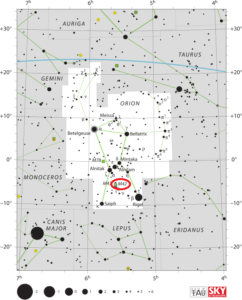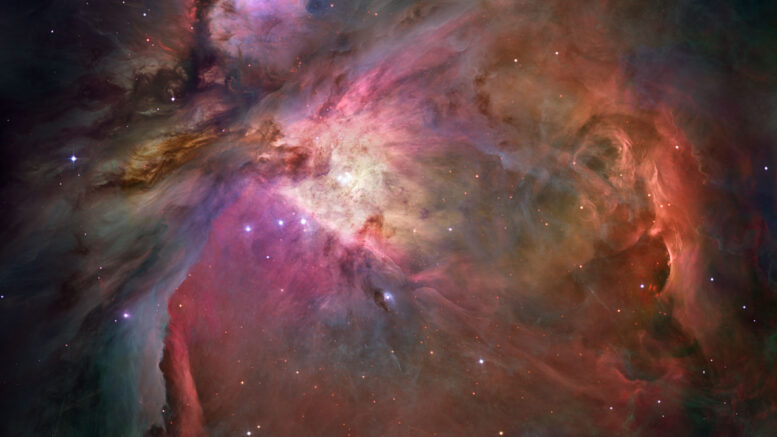Messier 42 (M42), the famous Orion Nebula, is an emission-reflection nebula located in the constellation Orion, the Hunter. The Orion Nebula is one of the most scrutinized and photographed objects in the night sky, and is among the most intensely studied celestial features. The nebula has revealed much about the process of how stars and planetary systems are formed from collapsing clouds of gas and dust. Astronomers have directly observed protoplanetary disks, brown dwarfs, intense and turbulent motions of the gas, and the photo-ionizing effects of massive nearby stars in the nebula.
| Description | |
| Visible From Pacific Northwest | October To February |
| Best Time To Observe | December and January |
| Minimum Size Of Viewing Device | Small Telescope |
| Object Type | Nebula with open cluster |
| Designations | Messier 42, M42, Orion Nebula, Great Orion Nebula, NGC 1976, Sharpless 281, 3C 145, LBN 209.13-19.35, LBN 974, PKS 0532-054, MWSC 0582 |
| Right Ascension | 05h 35m 17.3s |
| Declination | -05°23’28” |
| Constellation | Orion |
| Apparent magnitude | +4.0 |
| Apparent dimensions | 65′ x 60′ |
| Object Radius | 12 light years |
| Distance From Earth | 1,344 light years |
History
The nebula was not mentioned by Ptolemy, Al Sufi or Galileo, even though they documented their observations and listed a number of other objects in their works. Ptolemy catalogued the nebula as a single bright star in 130 AD, as did Danish astronomer Tycho Brahe in the late 16th century and German astronomer Johann Bayer in 1603. Bayer catalogued it as Theta Orion in his star atlas Uranometria. Galileo saw several faint stars in the region in 1610, but did not see the surrounding nebula.
The first to identify M42 as a nebula was the French astronomer Nicolas-Claude Fabri de Peiresc, who observed it with a refractor on November 26, 1610.
While Cysat may have also provided the first description of the Trapezium Cluster, noting that the central stars were a “rectangle,” the discovery of the cluster is credited to Italian astronomer and physicist Galileo Galilei, who detected three of the four main stars on February 4, 1617.
Locating M42 In The Sky
The Orion Nebula is very easy to find as it is located just below Orion’s Belt, a prominent asterism in the winter sky. The nebula appears as the fuzzy middle star in Orion’s Sword, which is formed by a vertical row of three stars (i.e. two stars and M42) south of Orion’s Belt. The nebula can easily be seen in binoculars and small telescopes. Covering more than a degree of apparent sky, the nebula appears over four times the size of the full Moon.

Viewing M42
Small telescopes at higher magnifications will reveal the four brightest stars in the Trapezium Cluster, an open cluster of young, hot, massive stars that were formed within the Orion Nebula. The four stars form a trapezoidal shape and energize the surrounding nebulosity.
Photographing M42
The amount of overall exposure time and the types of filters that were used can change the type of image you create dramatically. In the world of astrophotography, the more signal (light) you can collect, the better. An equatorial tracking mount and a telescope (or telephoto lens) are required for a deep view of the Orion Nebula, but even short untracked shot will begin to show color.
This celestial masterpiece is the perfect target for beginners to try using a DSLR camera and telescope. The bright, impressive details are quite evident in short, unguided exposures. As you learn how to better capture and process your astrophotography images, your image of M42 will become more and more beautiful.
A typical imaging session on M42 and the surrounding area will involve photographing several long exposure images that can later be registered and stacked to produce a final image with a healthy signal-to-noise ratio. In general you want the lens to gather as much light as possible in a single shot.
https://www.galactic-hunter.com/post/m42-the-orion-nebula
Sources And Further Reading
Descriptions of all of Messier Objects can be found here.
https://www.nasa.gov/feature/goddard/2017/messier-42-the-orion-nebula
http://www.messier.seds.org/m/m042.html
https://freestarcharts.com/messier-42

Leave a comment